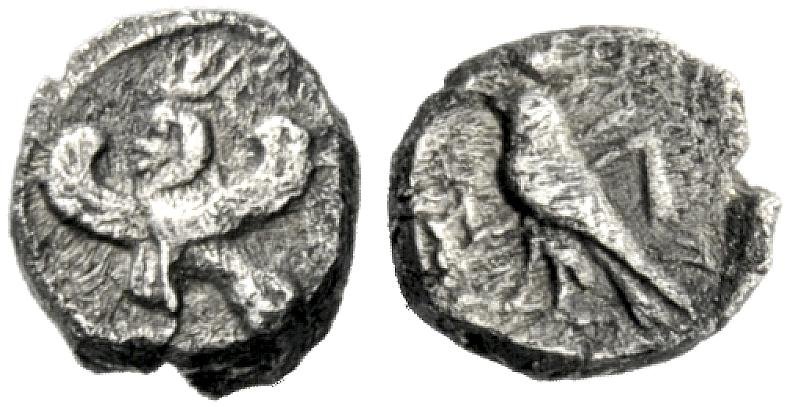S 1833 - Byblus (uncertain king), silver, 1/12th shekels (450-410 BCE)
From SILVER
450 BCE - 410 BCE Silver 393 kg
Description
| ObverseInscription or printing placed on the obverse.: | Sphinx seated l. Dotted border |
| ReverseInscription or printing placed on the reverse.: | Falcon standing l., wearing double crown of Egypt, crook and flail in background, all within incuse square |
Mint and issuing power
| MintIdentifies the place of manufacture or issue of a numismatic object.: | Byblus | Ancient regionAncient region.: | Phoenicia | Modern countryModern country: Lebanon | AuthorityIdentifies the issuing power. The authority can be "pretended" when the name or the portrait of X is on the coin but he/she was not the issuing power. It can also be "uncertain" when there is no mention of X on the coin but he/she was the issuing power according to the historical sources: |
Chronology
| FromIdentifies the initial date in a range assigned in a numismatic context. | 450 BCE | toIdentifies the final date in a range assigned in a numismatic context.. | 410 BCE | PeriodTime period of the numismatic object.: Classical 480-323 BC |
Physical description
| MetalThe physical material (usually metal) from which an object is made.: | Silver |
Median weightMedian of the weights of numismatic objects (in grams). in grams | 0.60 | DenominationTerm indicating the value of a numismatic object. Examples: tetradrachm, chalkous, denarius.: | 1/12 shekel | StandardStandard.: | Persian |
Image

S1833 Byblus uncertain king twelth shekels (450-410 BCE).jpg [1]
References
| Die study referencePublication of the study: | Elayi - Elayi 20141Elayi - Elayi 2014, p. 145-147, n° 73-93 | ||
| Coin series referenceReference to coin series study: | HGC 102HGC 10, n° 123 | ||
| Coin series web referenceCoin series web references: | |||
Obverse dies distribution
Reverse dies distribution
no distribution is available
Quantification
| Number of obversesNumber of obverse dies. ᵖ (o) | 11 | Number of singletons (o1)The number of singleton coins. ᵖ | 7 |
| Number of reverse diesNumber of reverse dies. (r) | 14 | Number of coinsNumber of coins. (n) | 15 |
| Coins per obverse dieNumber of coins per obverse die. (n/o) | 1.36 | Coins per reverse dieNumber of coins per reverse die. (n/r) | 1.07 |
| Reverse per obverse ratioRatio of obverse dies divided by reverse dies. (r/o) | 1.27 | Percentage of singletons (o1)number of coins (n) divided by the number of singletons (o1) ᵖ | 63.64 % |
| Original number of dies (O) (Carter 1983 formula)The estimation of the number of coins according to Carter 1983 ᵖ | 32.72 | Coins struck if 20,000 as average productivity per dieCoins made if the average productivity for obverses (according to Carter) is 20,000. ᵖ | 654,400 |
| Original number of dies (O) (Esty 2011 formula)The estimation of the number of coins according to the singleton formula in Esty 2011 ᵖ (O) | 41.25 | Survival rate if 20,000 as average productivity per dieSurvival rate if average productivity is 20,000. ᵖ | 0.00002 |
| Coverage (o = % of O) (Esty 1984 formula)Esty 1984 - coverage (% of O) ᵖ (o = % of O) | 53.33% | Die productivity if survival rate 1/2,000Average productivity if survival rate is 1/2,000. ᵖ | 916.87 |
| Weight of silver (in kg) if 20,000 coins per die (O = Carter formula)Carter 1983 * Median weight * 20000 (*10 if gold or electrum) ᵖ | 393 kg <br /> 393 kg | Die productivity if survival rate 1/5,000Average productivity if survival rate is 1/5,000. ᵖ | 2,292.18 |
Remarks